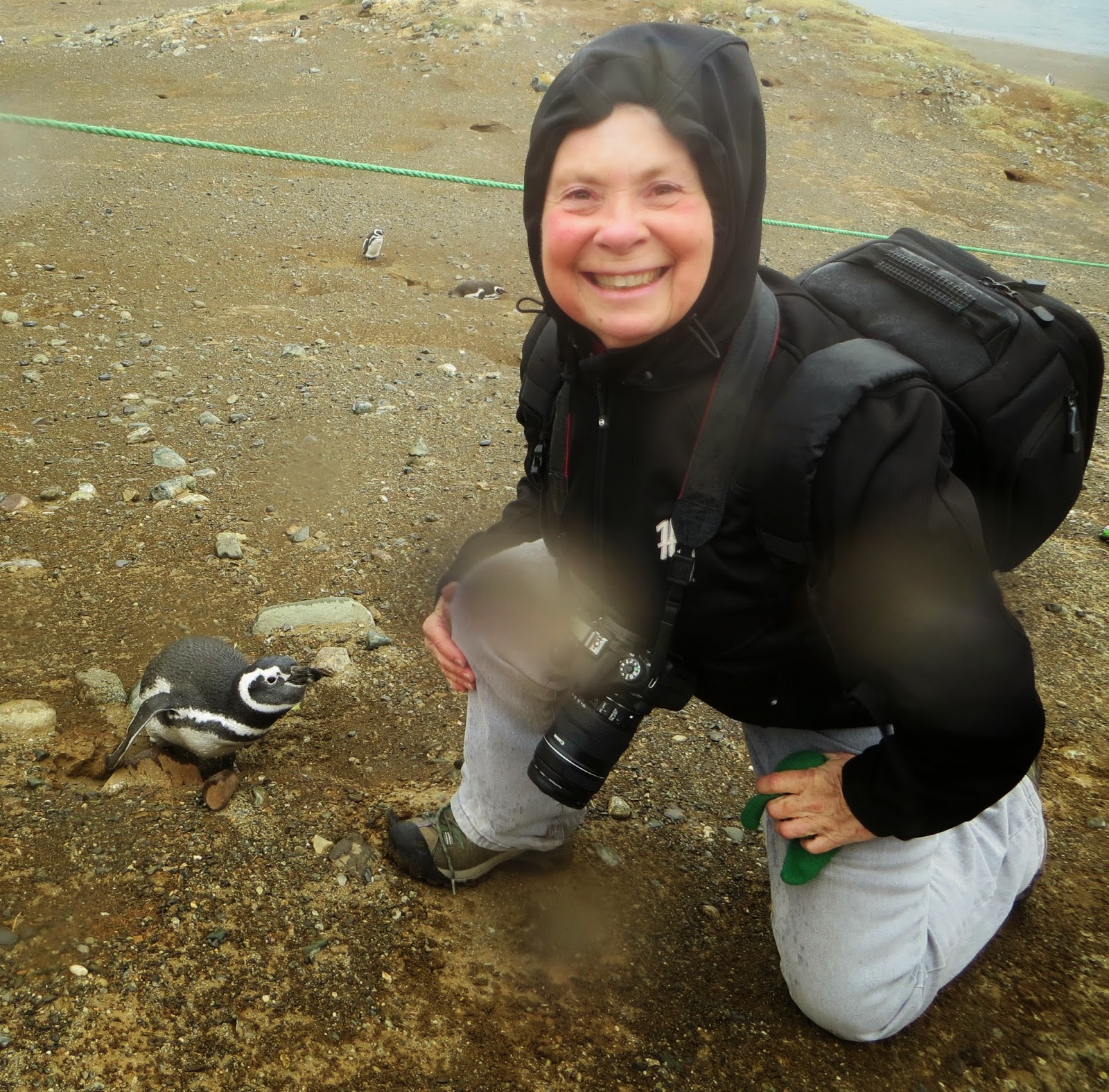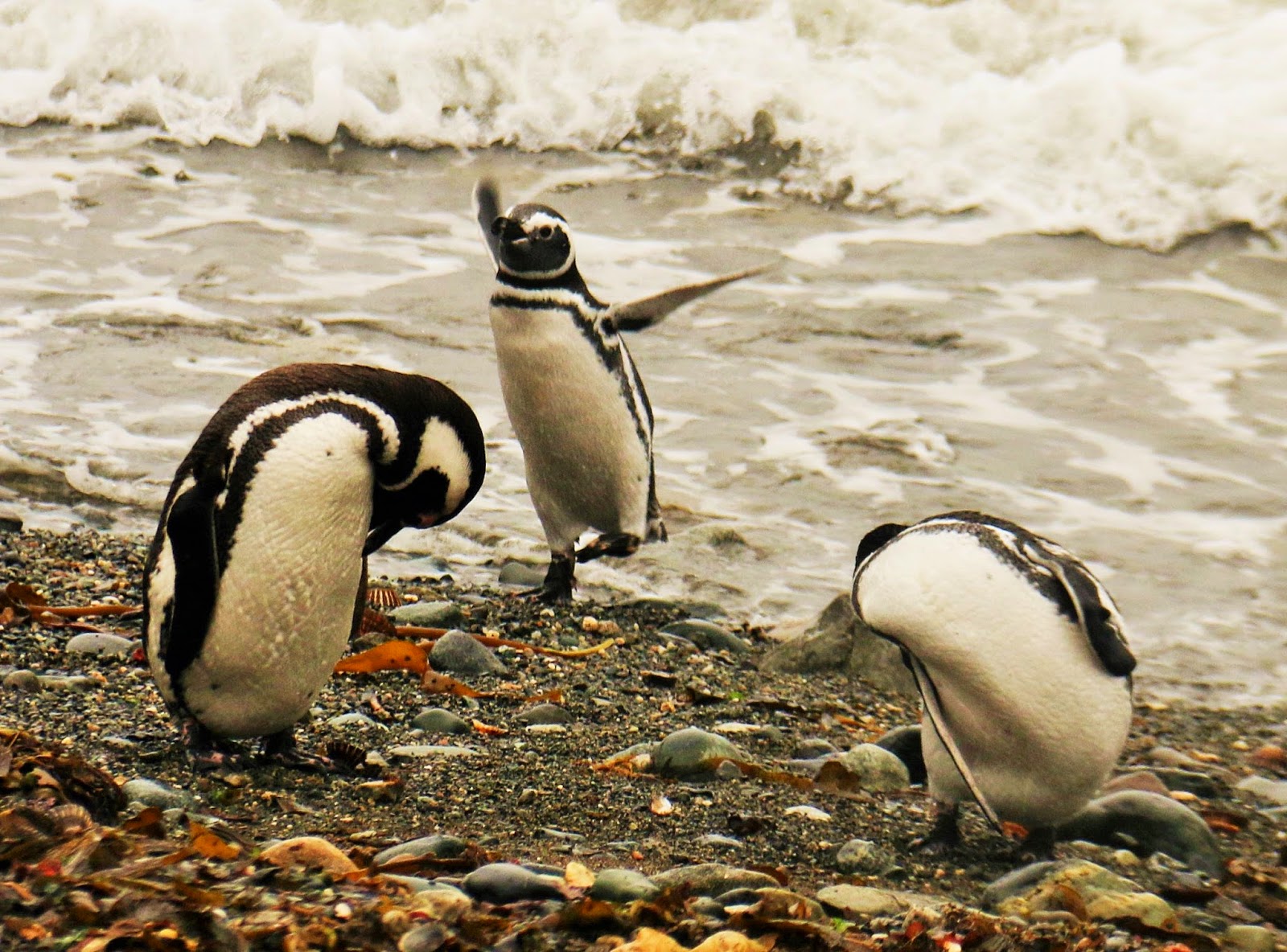We left Ushuaia, heading for Punta Arenas, Chile, and
hopefully the Magdalena Island Penguin Reserve.
We’re hoping that this time the weather will be cooperative and we’ll
get to go out. The Magellanic penguins
are the same type we saw before, mostly from a distance, in Puerto Madryn, Argentina,
but it’s supposed to be an excursion that will put us right in the middle of
them.
We arrived and the weather was not the best. It appeared that maybe another tour
cancellation was coming. We waited … and
waited … and waited, napping in the Princess Theatre. Finally, the announcement came that we had
received the go ahead to disembark onto the tenders.
.JPG) |
| The tenders dropped us off at the dock so we could head for busses. |
Yahoo. From the
tenders we piled into busses, then onto a landing-craft-style ferry. It was a no-frills type of transportation,
and would be a one-and-a-half to two-hour ferry ride. This ride was so worth what we got …
.JPG) |
| The ferry would take us to the island, about a two-hour ride. |
.JPG) |
| A walkway led us to the cabin where we'd ride to the island. |
A walk about with penguins all over is what I’m talking
about. There were penguins everywhere … in
their burrows that they dig for laying eggs and raising their young, usually
two, and standing guard at the entrances watching the two-legged mammals
approaching.
.JPG) |
| They are quite fuzzy as they are in the process of shedding. |
.JPG) |
| After shedding, they will migrate in April and return to the colony in September. |
.JPG) |
| This little guy looked like he was bowing. |
Some seemed quite curious.
Others slept through our visit. Most
just went about their daily business of walking along in their little
black-and-white tuxedos, testing the water, playing with others.
.JPG) |
| Some just laid down and didn't seem to care that we were there. |
.JPG) |
| Half in or half out didn't matter either. |
.JPG) |
| Just awalking along. |
.JPG) |
| And there he went. |
.JPG) |
| Swimming lessons. |
This is the type of tour we’d been waiting for … walking
along a path toward a lighthouse, with some of about 140,000 penguins on either
side, or even in the trail. They pretty
much do what they want, when they want, and it’s a good thing. It is their island.
.JPG) |
| Many were hanging about in groups. There was evidence the gulls had gotten some, but it appeared that the penguins had gotten more of them back as there were a number of dead gulls. |
.JPG) |
| Got an itch. |
.JPG) |
| What you looking at? |
.JPG) |
| This one in the burrow appeared to be playing hide and seek with me. |
.JPG) |
| All in a row, coming. |
.JPG) . . |
| And going. |
The day had turned for the worse, and not only was it dreary
with clouds and wind, it was raining, as well, and the rain began to pound
down. It did not dampen my spirits as I
was ecstatic to see these little critters.
They are as cute as can be although I expect they could peck the flesh
off your legs if you got too close. I
didn’t give any of them a chance to do that.
.JPG) |
| Flying practice for a bird that cannot fly. |
.JPG) |
| Of course, rain added to the fun of the visit. |
.JPG) |
| It's their island. They walk where they like. |
.JPG) |
| Yay. They're leaving. |
Punta Arenas was officially founded in late-1843, and is
located on the Strait of Magellan, on the southern tip of Chile. It’s the third largest city in the Patagonia
region and in 2012 had about 127,500 residents.
Supposedly this region is quite dry, with only about 1.7 inches of rain
in May, its wettest month; but you couldn’t prove it by us. However, the city is known for its strong
winds and we could vouch for that.
.JPG) |
| Our chariot awaits. |
.JPG) |
| Loading up to leave. |
.JPG) |
| It was more treacherous unloading with the wave action having increased. |
The city was originally named Punta Arenas, but in 1927 was
renamed Magellanas. That only lasted
until 1938 when it was changed back to Punta Arenas. I think that name has a nice ring to it.
We had a great day viewing penguins and even the return to
the ship was exciting as the seas were not flat. The little tender was rocking around but final
everyone got back on board and we set sail.
.JPG) |
| They brought us out of the port building to wait in a group in a tube that protects somewhat against the weather. |
.JPG) |
| It was also a feat to get off the tender again and back onto the ship. |
The next day, Tuesday, March 10, was quite a day.
It was still quite windy with 45 knots blowing across the bow. It set the tone for the day and the captain
slowed the ship’s speed to 9.6 knots, quite a bit less than half of what the
Golden Princess is capable of doing.
The ship was rocking back and forth, port to starboard, with
the stern and bow going up and down in the troughs of the waves. The ship was creaked and groaned loudly in
protest as we moved through the violent sea and the waves crashing against the
bow and on either side of us. We were
bobbing like a cork in the middle of open water and there were a lot of people
who weren’t faring very well with the rough seas. Doors were flying open, small items were
falling over or rolling onto the deck.
The captain had announced that we were experiencing rough water with
wave action to about 18 feet. We could
pretty much say we thought that was true.
But we were doing well and went to breakfast.
The windy, rainy weather and rough seas were expected for
most of the day and the decks were closed off, as well as the pools. We walked around and everyone we saw looked
as though they’d all been drinking … a lot, by the swaying and staggering. Walking on a treadmill was even more
challenging, but it had to be done, and there was no waiting. Jaz has been very consistent, while I haven’t
as I don’t like to go and stand in line waiting for one of the machines. Naps were in order for part of the day and then
we ran off to play Bingo, in the off chance that we would win the $1,400
jackpot. That was not to happen for us,
or anyone, today. But we caught the at-sea
fashion show and then headed to the room for a bit before dinner and the show
later on. It’s not been a bad day at
sea.
By 1:30 p.m. the wind had dropped to 32 knots, and it was 48
degrees; by 5 p.m. had calmed to 16.9 knots, nearly flat, and our ship had sped
back up to 19.9 knots. But we had lost
time on our schedule and had to bypass the channel we would have taken to see
the Amalia Glacier, a tidewater glacier that originated in the Southern
Patagonian ice fields. Our glacier
viewing was not to be today either, and even if we had, the weather was once
again not cooperative for a beautiful glacier photo.
.JPG)
.JPG)
.JPG)
.JPG)
.JPG)
.JPG)
.JPG)
.JPG)
.JPG)
.JPG)
.JPG)
.JPG)
.JPG)
.JPG)
.JPG)
.JPG)
.JPG) .
..JPG)
.JPG)
.JPG)
.JPG)
.JPG)
.JPG)
.JPG)
.JPG)
.JPG)
.JPG)
No comments:
Post a Comment